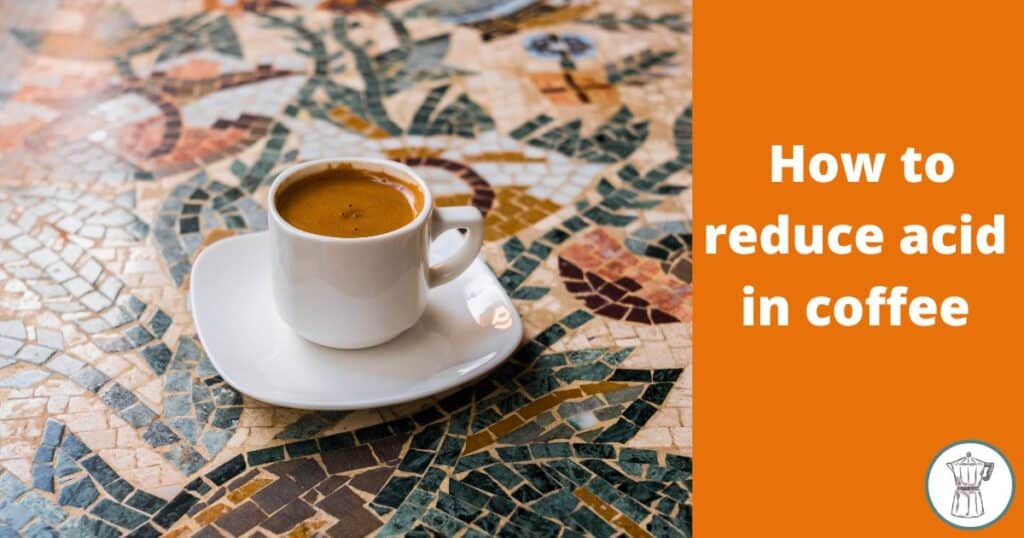How to reduce acid in coffee in a simple way?
The other day I was wondering whether there are easy ways to reduce acidity in coffee and I went online to find out more. In the end, I found a bunch of simple yet effective methods for bringing down the acidity in your coffee.
Let’s jump straight into it.
The importance of drinking low-acid coffee
Why is important to drink low-acid coffee?
Here’s a good reason:
Many people out there are suffering from stomach issues including GERD and acid reflux. This means that they have to give up on coffee so they allow their stomach to heal properly.
This, in practice, means that you can be proactive and drink low-acid coffee so you won’t face such health issues and at the same time, you can enjoy coffee every single day.
Plus, low-acid coffee tastes better. Acidic coffee tends to taste sour which really makes your brew almost undrinkable or a brew that you’re not 100% enjoy having. Low-acidic coffee is still slightly bitter and sour but not to the point that it’s off-putting.
8 free (or dead cheap) ways how to reduce acid in coffee
Let’s chat about 8 simple methods for reducing acidity in coffee.
1. Go for Arabica Beans
There are 2 main types of coffee beans: Arabica and Robusta
It takes Robusta beans longer to grow and mature which makes them have a higher content in caffeine and acidity – you can simply skip Robusta coffee beans and go for Arabica which has less CGA and so less acidity.
2. Use eggshells
How is this working exactly? Why eggshells?
I know it sounds like one of those odd DIY methods you find on Youtube, but it’s an easy method that has been around for some time and it really doesn’t cost you anything. All you need to do is use the eggs and wash the eggshells and let them dry out. Crash them, make a powder, and mix them up with your coffee grounds.
*Powder of half to 1 egg should be enough*
3. Use acid reducers
This is an effective method but you might need to pony up money.
Acid reducers contain calcium, potassium, and magnesium which all 3 elements contribute to reducing the acidity of your coffee. The good news is that they don’t really change the taste of your coffee. Simply put you can drink low-acid coffee that tastes great by using an acid reducer.
How effective they are?
They reduce acidity in coffee by over 90% which is almost all of the acidity level in your cup.
You can find them pretty much everywhere, from your local off-license to supermarkets or online – there are plenty of them on Amazon. I haven’t used 1 personally, but from what I’ve heard, a great 1 is Coffee Tamer.
4. Use a paper filter
A paper filter is a great way to block excessive amounts of acidity ending up in your cup.
If you use an Aeropress or a dripping coffee brewer the odds are that the filter is mandatory, but brewing with a French press can be done without a filter, meaning that your coffee is going to be acidic. By adding a filter underneath the plunger you it’s going to filter coffee oils and lipids and this will lead to less acidic coffee.
What sort of paper filter should you use?
The most common paper filters you can find are white (it contains bleach) and brown (it doesn’t contain bleach). The white ones sometimes leave a slight hint of bleach in your drink, so I suggest you go for brown paper.
5. Use alkaline water
This is another great way of bringing down the acidity level in coffee.
Did you know that alkaline water is less acidic than regular water?
The pH of alkaline water is 8 while the pH of regular water is 7, meaning that alkaline water is less acidic.
It’s definitely a great option for brewing as it contains calcium and magnesium. Plus, coffee made with alkaline water tastes simply fantastic.
Are there other benefits of drinking alkaline water?
Yes, alkaline water improves your immune system and it’s also rich in certain minerals our body needs to function properly.
6. Not too hot water
As you might have guessed over 90% of a cup of coffee is water.
So the water and more specifically the water temperature of your brew can make a whole lot of difference when it comes to the acidity level of your coffee.
It’s no good to use too hot water for brewing. I know, many of us do it just to speed up the process to enjoy our coffee. But too hot water makes the coffee grounds extract too much caffeine and acidity (often called over extraction), making your coffee too acidic.
What’s the ideal temperature for brewing then?
The ideal temperature for brewing coffee is between195°F (91.7°C) and 205°F (96.1°C).
As long as you stick to this temperature range, you’ll be just fine.
7. Avoid keeping coffee in thermos
It’s always handy to have 1 as you can fill it up in the morning and take it with you at work or wherever you’ve planned to go.
But the trouble is the flavours and aromas don’t last in thermos or any other sort of containers. In fact, the coffee loses most of its flavours and aromas after just 30 minutes, meaning that the sooner you have, the better it’s going to taste.
What about the acidity level? Well, it’s getting slightly more acidic when coffee stays in a thermo, so as I already said, it’s wise to have your coffee soon after brewing it.
8. Baking soda
Have you ever tried coffee with baking soda?
It sounds odd, right?
It’s true though, baking soda can reduce the level of acidity in coffee. It’s an alkali which means that when it’s mixed up with coffee it neutralises the level of your brew’s acidity. All you need to do is pop a pinch of it in your brew.
How much should you put?
A great rule of thumb is to add 1/4 tsp of baking soda, more than this little dose might spoil the taste of your brew as baking soda when mixed with water and coffee releases little carbon dioxide bubbles and this might make your drink too bubbly.
Let’s wrap it up
That’s a wrap, I hope you learned a thing or 2 on how to reduce acidity in coffee. Stay tuned, I’m going to write more articles about coffee, and acidity and share tips on how to master the art and science of brewing to help you impress your friends and family with your barista skills.
FAQ
This is one of the most popular sections of this blog’s readers. Let’s take a look at a couple of FAQs to get a better understanding of the topic.
What to do if coffee is too acidic?
Luckily, there are many ingredients you can add to your coffee to make it less acidic. One of them is milk which is a simple yet effective way to reduce acidity in coffee. All you need to do is add a splash of it to your brew and this will be enough to bring down the acidity of your brew. Another dead easy way is to add a sprinkle of baking soda which is also going to be enough to reduce the acidity level of your brew.
How much baking soda to add to a cup of coffee to reduce acidity?
Here’s the deal with the baking soda…
You don’t need much of it. In fact, you only need 1/4 tsp of baking soda. If you go for too much soda, you’ll end up with a drink that it’s almost undrinkable and it’s a shame to spoil your coffee. This happens because when baking soda is mixed up with water or coffee it reacts and releases carbon dioxide and this makes your drink fizzy. Unless you’re a big fan of fizzy coffee (I’m not sure if you’ve ever tried it, I haven’t), it’s not wise to spoil the taste of your coffee with too much soda.

- How to Remove Coffee Stains From Countertop The Easy Way - December 21, 2023
- Can You Reuse Coffee Grounds in French Press? Truth Inside - December 12, 2023
- Can Expired Coffee Creamer Make You Sick? 3 Ways to Find Out - December 9, 2023
